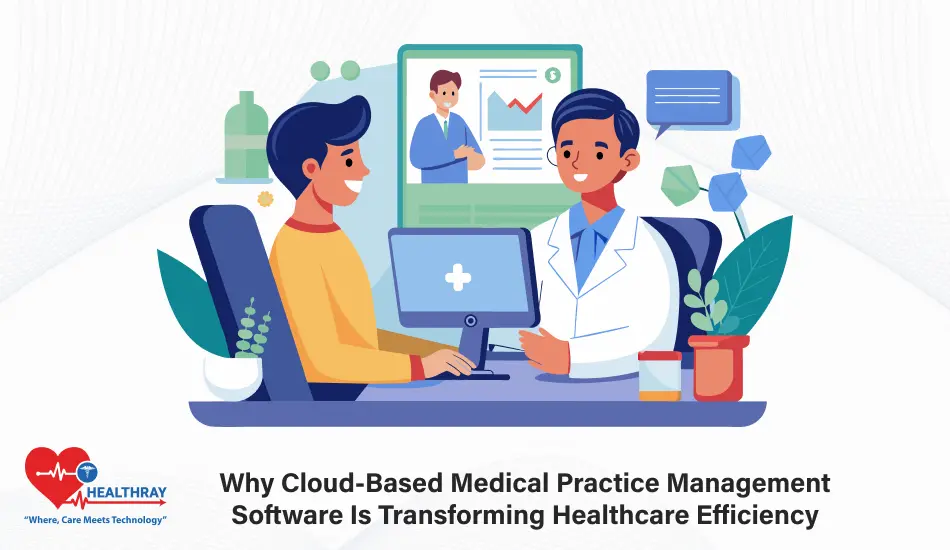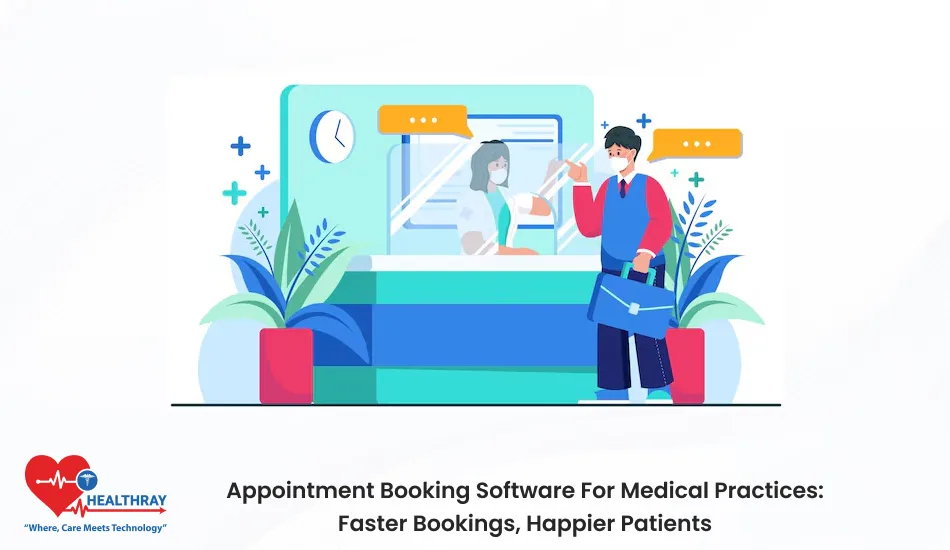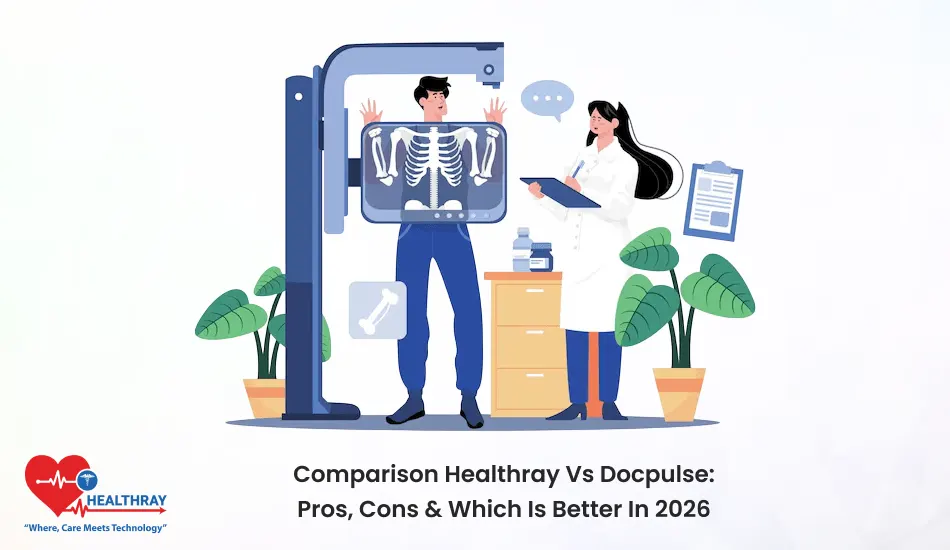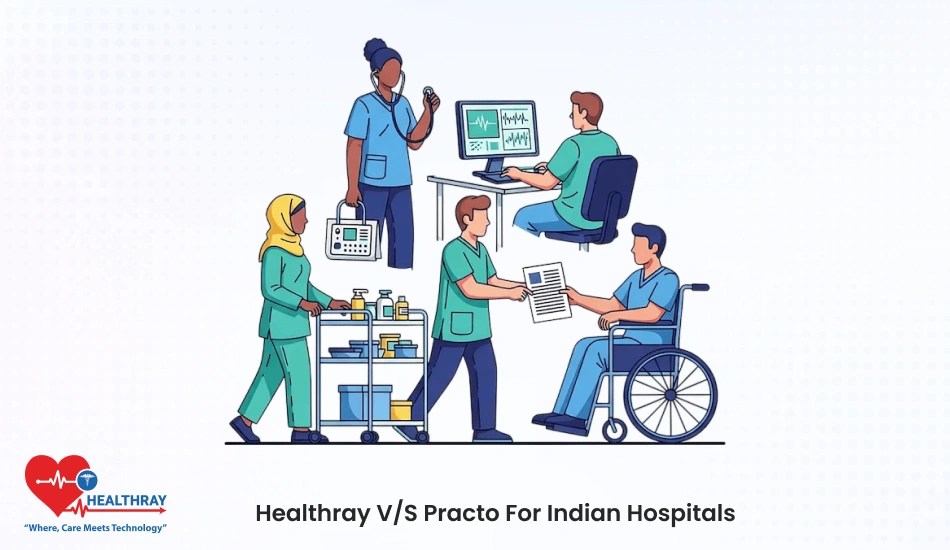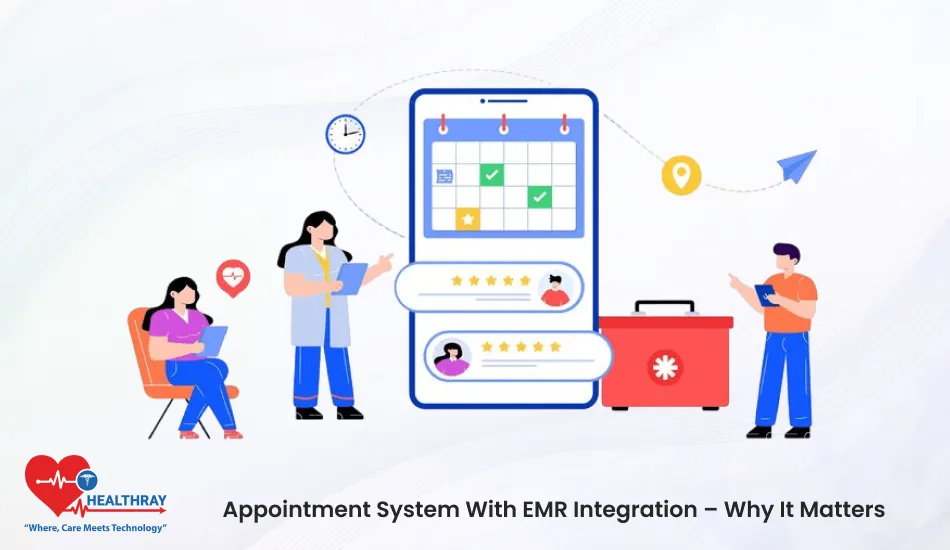Summary
The Mumbai or Miami hospitals are on the brink of being outmoded systems all over the world. Administrators often spend valuable time chasing data instead of caring for patients, while clinicians struggle with multiple screens that fail to connect.
As a result, cloud-based medical practice management software is taking center stage in the new healthcare era.
This technology eliminates the maze of paperwork, connects all departments, and offers real-time visibility to the decision makers.
In particular, Healthray – one of the most popular software solutions in hospital administration – demonstrates that efficiency is not a fairy tale but a deliberate design decision.
Introduction
Nevertheless, hospitals are superb when it comes to saving lives, yet dismal when it comes to saving time.
Even the most progressive organizations continue to rely on tools built a decade ago. Nurses juggle ten logins. The billing teams paste the information from one program to the other. Physicians wait for lab updates that should appear instantly.
It’s not laziness; it’s legacy.
The older software used in healthcare was developed during the era of on-site servers, when cloud connectivity was still a fantasy. Nowadays, the same mechanisms slow down the speed, flexibility, and morale of the staff.
For this reason, Indian and American hospitals are beginning to transition to cloud-based healthcare software – an ecosystem that lives on the Internet, updates automatically, and evolves effortlessly over time.
Healthray is a reputable partner among the leaders. Its platform unites scheduling, records, billing, analytics, and communication in a single secure dashboard. Concisely, it is medical practice management software that it is time to act like it knows healthcare.
Learning Medical Practice Management Software on the cloud
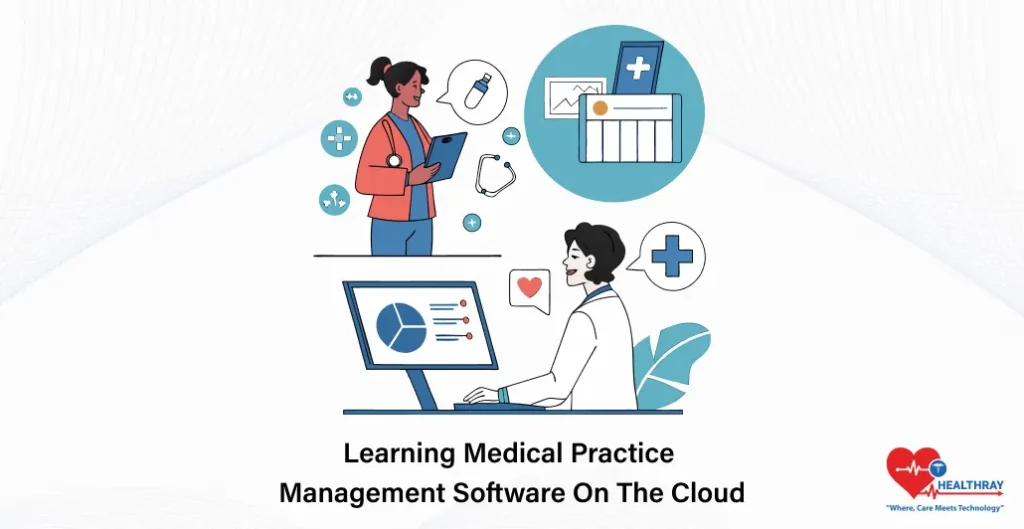
What It Is and How It Works
Consider cloud-based medical practice management software as an online nervous system of a hospital.
Now, systems run over the internet instead of local servers. Authorized users – doctors, nurses, accountants, and administrators – can access the same updated information anytime, anywhere, from any device.
The result?
There were no more lost files, an unending backup, and version confusion. Lab technicians enter results that instantly appear for the treating physician. Moreover, the finance head reviews a payment as soon as posted by a cashier.
Cloud systems evolve automatically, unlike boxed software that requires heavy installation. They update without interruption, and compliance features refresh silently in the background. IT firefighting leaves hospitals flexible.
The Case of Moving Away from Legacy Systems at Hospitals
An old on-premise setup may look stable, but when neglected, it drains resources. Moreover, hardware is costly with every upgrade. Every failure interrupts the work process.
These systems tend to break even as the number of patients and data complexity increase.
This is the reason why administrators are looking for the most appropriate medical practice management software solutions that expand with their growth. Moreover, cloud infrastructure allows them to add beds, departments, or even branches without having to reconstruct them. The model of Healthray is very attractive in India, where people have low budgets but high ambitions.
Starting with a free level of hospital management software, hospitals can always upgrade the software as the needed functions become more and more frequent.
The Efficiency Problem of Contemporary Healthcare
The Underwritten Expenses of Paper and Obsolete Systems
Any additional minute that a nurse is typing rather than treating is a cost. Every duplicate report that requires verification adds unnecessary cost. Multiply that by hundreds of members of staff, and inefficiency will be a silent budget killer.
Hospitals that have continued to work with old medical practice software experience increasing administrative waste -paper logs, manual billing checks, and endless coordination meetings. Moreover, they are not some small inconveniences; they are operational fractures.
The Inefficiency of Human Impact
It is counterproductive for people to be past spreadsheets and dashboards.
Systems that slow personnel fuel burnout. Delays and asking the same question create disorganization for the patients. When that happens, confidence drops, morale declines, and performance stalls.
The answer to the issue is not in a patch and is in a paradigm shift.
Through single medical practice management system, hospitals will regain the lost clarity, reduce the redundancy, focus on the healing process rather than housekeeping by adopting a single medical practice management system.
The Way Cloud-Based Management Software Helps to Resolve Operational Chaos
Live Access and Data Incorporation
Cloud solutions unite all the areas of a hospital via a single stream of data.
Doctors revise prescriptions, labs record test results, and billing verifies insurance – all this happens in real time. Moreover, connectedness destroys the so-called telephone game that wasted hours.
Smarter Timing and Workforce Management
Scheduling software within the main hospital management systems predicts workload, avoids the occurrence of double bookings, and balances staff allocation. Where the calendar of one surgeon changes, the system automatically triggers the system alert to the concerned departments. Also, it saves time in this case is directly proportional to quicker patient throughput.
Harmonized billing and financial management
Coding errors or missed claims cost hospitals revenue.
The cloud automates the billing policies, attracts attention to anomalies, and integrates them with accounting applications. Modern tools improve financial transparency, simplify audits, and shorten revenue cycles.
The reason why Healthray is distinguished in the revolution of the cloud
Hospital-centered, Person-centered design
Hospitals should design systems around people – not force people to adapt to systems. Healthray embodies that principle. Its user interface reflects the workflow of a natural hospital: on the left side, there are admissions, in the middle, the scheduling, on the right side, the billing, and the reports. The few clicks and the highest level of clarity.
Unified Ecosystem: Between Appointment and Analytics
Most organizations manage medical workflows across departments using disconnected software.
Healthray merges them. By scheduling appointments, Healthray automatically updates patient records and integrates them with billing and analytics. The languages are all the same, and the managers are able to see the entire process of a patient with one eye.
Integration and Interoperability
Hospitals rarely start from scratch; they already use lab systems, pharmacy databases, and imaging tools. Healthray’s open APIs enable seamless integration, making it one of the most adaptable medical practice management solutions available. Also, it builds up what is already existing rather than displacing it.
Information Protection and Legal Regulations
The primary reluctance that most administrators experience in transitioning to the cloud is security anxiety. Healthray addresses that, with built-in encryption layers, limited access policies, and automatic compliance policies, sensitive data will be secure in the Indian regulatory environment and the HIPAA system of the USA.
Benefits of Adopting the Cloud-Based Practice Management Systems

Efficiency Gains
Hospitals that integrate cloud systems show that running costs drop significantly. The system automatically populates forms and generates reports with a single click. Teams save hours that manual work once consumed.
Cost Optimization
The hospitals pay for what they use instead of purchasing servers and upgrades, which are in constant use. The transformation of the capital expenditure into the operating costs will release the budgets to acquire better equipment and manpower.
Scalability and Flexibility
Scalability is relevant both in the case of a city hospital network in New York and a rural clinic in India. Cloud architecture allows one to add users, roll out departments, and add data without the need to upgrade a single wire.
Enhanced Team Work and Communication
The doctors, nurses, pharmacists, and accountants are all working on the same platform. This kind of unity reduces the misconceptions and improves the coordination of the patients.
Patient-Centric Experience
Patients benefit because waiting times shrink and billing becomes simple. Also, it records access improves. Cloud platforms quietly restore the human side of care.
Application Routing: Legacy System to the Cloud
The migration of an outdated server environment to a new cloud-based medical practice management software is not a technology project, but a culture change.
Furthermore, the hospitals that relied on large local computers and hard copies are also getting to know that digital transformation is more of an attitude than equipment.
Evaluate What You Have
Any adventure begins with truthful introspection.
Most hospitals still work with a set of tools, where one of them performs an appointment, another one a bill, and one or two worksheets of Excel to manage the pharmacy stock. The first one is to chart this jungle. What are still valuable applications? Which ones consume time?
As an example, in India, hospitals discovered that legacy management software fails to meet regional compliance needs. Additionally, most facilities in the United States experience the inability of old systems to meet the HIPAA reporting requirements.
By understanding what’s broken, administrators make smarter migration decisions for the future.
Choose the Right Partner
It does not lack the number of sellers boasting about the most appropriate medical practice management software, yet few of them are familiar with the rhythm of hospital functions.
Being a good partner is not just about being a seller, but a strategist.
It is this mix of technical engineering and empathy in healthcare that makes Healthray very unique and particular. Moreover, the teams lead the hospitals with evaluation, migration, and live support, to make sure that the adoption is zero-disruption.
Healthray will even offer a free hospital management software tier to have a trial run on features, to institutions wary of cost. In this pilot model, leaders build internal buy-in before a full rollout, an approach that works especially well in cost-sensitive areas of India and mid-sized community hospitals in the U.S.
Organize a Progressive Implementation
Hospitals don’t change overnight. Teams migrate department by department.
The administration office may take the lead by implementing medical practice software to schedule and manage the human resources. Also, the clinical and the finance teams then follow.
The cloud systems are modular and thus, the departments can be interconnected without affecting the rest. It is such an extension of a hospital wing – the new areas fit the blueprint well.
At this phase, the communication about the leadership is important. Frequent progress reports, open forums, and visible wins ensure that morale is always high and staff are confident.
Train, Test, and Trust
Any good technology cannot do without trust.
At the same time, even medical practice management software that is intuitively created requires proper orientation. Moreover, training sessions must go beyond simple button-clicking; they should clearly explain why workflows are changing and illustrate how each role will benefit.
The interface of Healthray is designed to be familiarised with in a short time. Healthray’s dashboard closely mirrors actual hospital operations; as a result, clerks, nurses, and doctors adapt quickly after minimal exposure.
However, the adoption process becomes even smoother when hospitals invest in super-user programs or train select staff who actively champion the change.
Because employee retention in India can be extremely low, regular micro-training – through short videos or in-app modules – serves as an effective remedy to maintain consistency.
Meanwhile, compliance auditing in the USA remains much stricter; therefore, conducting simulation testing before go-live ensures there is no data inaccuracy from day one.
Continuous Improvement
However, cloud transformation is not the destination, but a call to grow. The analytics dashboards will reveal hidden insights once hospitals implement the new medical practice management system.
Do hospitals underuse weekend bed capacity?
Which departments are the most queried by the patients?
Such trends enable administrators to keep on improving processes.
Healthray holds quarterly optimization meetings to help clients track progress and adopt new modules – such as teleconsultation or pharmacy management – when they’re ready. Moreover, the company drives steady, long-term growth rather than one-time change.
Principles in Practice: Healthray in Action
Case Study 1: Frustration to Flow
One of the mid-sized multi-specialty hospitals in Pune had long-term coordination issues. Patient intake, diagnostics, and the process of billing were available on different platforms. Also, it is feasible to communicate through emails and paper files.
The management team chose Healthray, one of the best medical practice management programs, which also balances India’s economy with global reliability.
They implemented it in the outpatient department, and within weeks, resolved all scheduling conflicts. The process of confirmation of appointments went on to activate automatic changes in the electronic record and the pharmacy queue. Billing synced instantly.
Physicians were able to see the full treatment history of a patient at a glance, once more – tests, prescriptions, billing, etc., in the same cloud-based health care software platform.
Step towards digital era with our healthcare solution
Revamp your hospital facilities and embrace change for better healthcare management. Ease in managing and organizing large medical datasets leads to effective analysis. Seize the opportunity now!
Case Study 2: Effectiveness at the Crossroads
Across the ocean, a regional hospital network in Texas sought better visibility across its three branches. It was not possible to see real-time occupancy or staffing with on-premise databases. Since the implementation of Healthray, all facilities can be followed by the administrators with one dashboard.
Basically, the data spoke for itself: shorter patient wait times, happier employees, and faster revenue flow. Such malleability made data a business safety net.
Results That Matter
The figures were eloquent without using spreadsheets: reduced waiting time for patients, improved employee satisfaction, and accelerated the workflow of revenues. Previously, departments that used to get lost in paperwork worked together easily.
Most importantly, leadership got some space to think strategically as opposed to combating fires on day-to-day glitches.
The Future Healthcare Efficiency
Innovation in the Horizon
Technology is something that does not stand still, and neither does medicine. Moreover, the future medical practice management software will be based on merging automation and intelligence.
AI modules already identify scheduling patterns to forecast surges. In the near future, they will predict the amount of staffing required or identify discrepancies in billing before auditing.
Wearable devices and Internet-of-Things sensors in both the United States and India are making the meaning of connected care grow ever larger. Real-time data flows directly into cloud-based software medical practice management that enables clinicians to make informed decisions in real time.
Global Collaboration
The pandemic demonstrated the fact that there are no boundaries to collaboration. Indian hospitals are consulting their specialists in the USA over telehealth modules within medical practice management software in India. On the other hand, US-based research focuses on anonymized data on the cases in India to enhance population health models.
Cloud technology makes this exchange both safe and simple.
Moreover, cross-continent relationships based on software to handle medical practice workflow will be the new rule, with an improvement of compliance frameworks across the globe.
Why Waiting Costs More
Whether or not hospitals need to modernize is the question, but how long can they afford not to do so?
Each year of lost time adds to the losses: revenue lost, unnecessary work, and demotivation among staff.
Hospitals can turn stagnation into scalability by replacing the medical practice management software with cloud-based ones. Additionally, the platform is self-paying in terms of the time saved and less maintenance.
Active leaders consider modernization a project of patient care and not an IT project. It is all the same; smooth systems produce smoother teams, and smoother teams give safer care.
Conclusion
Healthcare has been a complex and balancing act.
Yet the world keeps accelerating and overflowing with data, shaking the balance – unless the right technology supports it.
Modern hospital management software bridges that gap.
It streamlines administrative mess through centralized workflow, minimizes redundancy, and maximizes coordination by means of collaboration.
Cloud adoption in India, where the hospital chains are growing at an alarming rate, translates to national coverage and retaining local responsiveness. In the U.S., where compliance pressures never stop, hospitals stay ready without relying on manual control.
Healthray is the company that has always managed to demonstrate that design is everything. Moreover, it is user-friendly dashboards, modular design, and security-oriented design show why its medical practice management software ranks among the best in the world.
In contrast to stiff legacy products, the cloud-based healthcare software developed by Healthray adapts with every new hospital supported by it – specialties, patient volumes, and regulatory requirements. It does not substitute people, it enhances them.
In the end, technology’s role in medicine remains simple: it is to make the care more human by eliminating sources of distraction.
Hospitals that see efficiency as empowering patients, not just cutting paperwork, represent the future.
Whether you are operating a tertiary-care hospital in Delhi or a community hospital in Dallas, the message is the same: Be innovative, believe in the cloud, and leave the smart medical practice management software to do the heavy lifting.
When systems work, doctors think, patients heal faster, and healthcare finally feels whole again.
